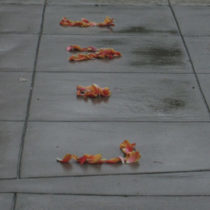Landscape Architecture for Landscape Architects › Forums › DETAILS & MATERIALS › Tree Stakes
- This topic has 1 reply, 9 voices, and was last updated 11 years, 7 months ago by
 toby.
toby.
-
AuthorPosts
-
April 14, 2013 at 2:24 am #155202
 jennifer BlochParticipant
jennifer BlochParticipantHello People,
Does anyone have experience with
Tomahawk Tree Stabilizers?
http://www.borderconcepts.com/uploads/cms/file/Border_Concepts-9-24-09.pdf
Thanks,
Jennifer
April 14, 2013 at 8:39 pm #155215 tobyParticipant
tobyParticipantlooks like the http://www.treestaple.com/
April 14, 2013 at 8:42 pm #155214 jennifer BlochParticipant
jennifer BlochParticipantYes – looks like the same technology. Do you have any firsthand experience with these Toby? Wondering if they are as reliable as stakes and guy wires? Thanks!
April 15, 2013 at 4:17 am #155213 tobyParticipant
tobyParticipantguy wires alone imo can be dangerous.
staking might be better, but only if the poles are in the undisturbed soil outside of the rootball and backfill. i’ve seen more tilted 2-staked trees that can never be righted. 3-stake trees are somewhat better long term.
the stake on container trees is there to lend strength to an undersized trunk with an oversized canopy. get rid of it asap, even if the canopy needs to be lightened and some mid height stake-to-tree has to be added to keep it upright. better is to get trees that don’t need that trunk stake at all.
this is a white oak, and i had nothing to do with it.
the staples rely on a solid rootball and solid ground around it. you might have trouble on sandy soil, but they will work nicely on trees that are for the most part self-supporting. the staples won’t prevent wind loading a self-supporting young tree to breaking point, so no matter what, stakes might be necessary for a while.
backfilling the pit properly is most important. convince whom ever is backfilling to use a sledge hammer to pound the soil down in 3 inch lifts.
NEVER dig the pit deeper than the rootball minus two to three inches, or wider than the rootball + a foot. if it’s too deep and backfilled, the partially compacted soil below will compact over time and the tree will sink. and tilt.
April 15, 2013 at 4:31 am #155212 jennifer BlochParticipant
jennifer BlochParticipantThanks Toby.
April 17, 2013 at 10:03 pm #155211 Rob HalpernParticipant
Rob HalpernParticipantWhile staking trees is most often not best for the long term health of the tree, it is still advised in some situations. For small tree, the stakes can make up for the root system that ought to stabilize the tree.
But with a 96″Box tree, I can’t imagine that, in the event of a huge wind event, the stakes are going to stabilize the tree.
April 18, 2013 at 4:27 am #155210 jennifer BlochParticipant
jennifer BlochParticipantI think the same Rob. Thanks.
April 18, 2013 at 11:33 am #155209 Andrew Garulay, RLAParticipant
Andrew Garulay, RLAParticipantISA staking guidelines for trees over 3″ caliper show them to be cabled down to a stake or anchor at about a 60 degree angle with 1/2″ hose protecting the tree and surveyors flagging tied to the cables to make them visible. The 96″ crate would indicate that the tree is more than 3″ caliper
Vertical posts with the tree tied to them horizontally are recommended for trees under 3″ caliper.
You might be able to get a dwg detail from their website – International Society of Arboriculture
April 18, 2013 at 7:43 pm #155208 jennifer BlochParticipant
jennifer BlochParticipantThank you so very much Andrew.
JB
July 6, 2013 at 4:13 am #155207 Tree_StakeParticipant
Tree_StakeParticipantAs a future reference we manufacture a reusable below grade tree staking system, that is gaining allot of popularity in DFW and Houston. ‘Our Safety Stake Root Anchor’ has been installed on several projects at Texas A&M, Texas Tech, Univ. of North Texas, TCU and Baylor Univ. along with 100’s of other projects. PDF drawings are available on the website and please call or emailfor Reference List, Technical and Installation Drawings .
903-676-6143
Thanks, Jeff Tuley
April 24, 2014 at 5:11 pm #155206 Chad WeinandParticipant
Chad WeinandParticipantIMHO, I do not think these are a good solution for the simple fact that, if installed as detailed on the manufacturers website, only the soil is stabilized and not the root structure of the tree. Therefore, when the wind blows, it causes the tree to rock back and forth, pulling on all of the roots attached to the tree, which means the smallest roots are being dislodged from the main roots. And since the smaller roots are the most numerous and are the ones doing a lot of the moisture and nutrient uptake for the tree, not having them will cause the tree to be slower to establish or worse, die. So I am currently rejecting these that were subbed out for the traditional stake and wire method for this reason, contractor subbed them without approving. I think the legal or dangerous aspect of the stake and wire system is ridiculous, although, supposedly, someone sued WalMart for injuries sustained on their property from traditional tree staking and won. I would ask what they were doing in the landscape or lawn area and what damage they may have caused there, and I would also say shame on the legal system for setting this precidence.
April 25, 2014 at 1:20 am #155205 Jason T. RadiceParticipant
Jason T. RadiceParticipantMost trees don’t need staking at all if planted properly. Most of the time it isn’t done right anyway, and just ends up hurting the tree.
April 25, 2014 at 4:49 am #155204 Goustan BODINParticipant
Goustan BODINParticipantI back-up Andrew : saw the drawing specs on ISA website (they provide PDF and CAD if I remember well) + matches the field practice when I was doing planting.
April 27, 2014 at 5:39 am #155203Ernst Glaeser
ParticipantHi Jason, I got to disagree here. No matter if bare-rooted, container grown, or root-balled, no matter if just the calliper of a pencil or a mature Methusalem, as long as the tree is exposed to the wind this movement caused to the root system will disturbe the new growth of the adventive roots and with that harm the plant. The root system and the trunk have to be fixed to the ground until the tree is established. The way to do it and the length of period for it to stay is more an asthetic issue.
-
AuthorPosts
- You must be logged in to reply to this topic.


